Safety systems
Safety systems
When there is fire or flooding in a ship the Safety Systems are there to give detection of these events at the earliest time, warn crew and passengers and limit the effects as much as possible. The aim of these actions is to keep the ship in a condition that it remains afloat and safe for crew and passengers to remain on board.
Safety systems can be:
1. Fire safety systems related to the prevention, detection, alarming, encapsuling (limiting to a space) and extinguishing of fires.
2. Crew and passenger safety systems related to alarming people in case of fire or a general alarm and safe evacuation.
3. Watertight subdivision of the ship as well as the outside hull openings.
4. The ship as its own lifeboat.
General
When one fire zone or watertight compartment of the ship is damaged all safety systems shall continue to operate in all other sections. That means that cables have to be carefully routed, and that fire resistant cables and junction-boxes have to be used for those systems that should remain in operation when a fire or flooding incident occurs. Fire detection systems cabling has to be routed carefully and when passing from one zone into another or from one engine room into another, the cabling has to be separated. In this way the detection system continues to monitor all the not yet affected zones.
A public address system, for information to crew and passengers, as well as abandon ship alarms or fire alarms need to have duplicated amplifiers and duplicated fire resistant cable routes. The junction boxes to the individual speakers have also to be fire resistant, with fused circuits to each speaker. Power for fire fighting systems and control systems shall not be hampered by a failure in an adjacent zone. So emphasis has to be laid on cable routing and partly fire resistant cabling.
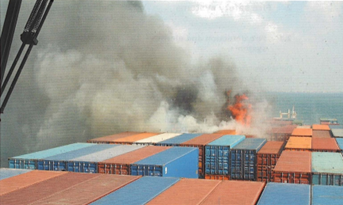
Fire in a container on a containership
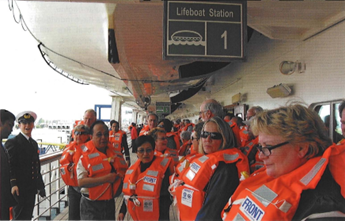
Mustering excercise
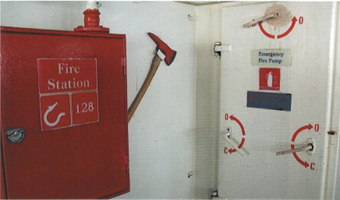
Fire station. Hydrant and hose inside the box
1. Fire safety systems
1.1. Fire detection and alarm systems
Detectors consist of heat detectors in galley and laundry, smoke/ heat detectors in cabins and public spaces and smoke/ heat/flame detectors in engine room spaces. Most systems for larger ships are addressable so that a fire is pinpointed to a cabin or limited space and not to a complete loop that covers a fire zone with many spaces, and many detectors. This makes it easier to attack the fire.
1.2. Fire doors and fire dampers
Fire doors and fire dampers are automatically operated by the detection system or by a heat melting fuse inside the fire damper. Fire doors separate fire zones by closing corridors, normally by deactivating a magnet, keeping the door open when de-activated. Fire dampers act the same way in airconditioning trunks in the accommodation and in ventilation ducting of in- and outlet trunks of the engine rooms. In addition to the magnet controls, automatic melting fuses are fitted in the larger dampers to close the damper in case of a high temperature at the fire damper.
1.3. Deluge (drenching) systems
Deluge systems use seawater for car decks of ferries. Dry, open systems are mostly used. When a fire is detected on the car deck the crew will manually start the deluge pumps. The deluge pumps will then pump seawater under high pressure to the effected section of the car deck.
1.4. Local fire fighting
Systems to extinguish a local fire on an engine. In addition to the detectors of the general fire detection system above main auxiliary engines, locally dual detectors are fitted. They operate a shut down and fire extinguishing function for the particular engine. All engines have individual systems so that a local fire will not shut down more engines.
Water mist or ultra fog is mostly used for such a local system.
1.5. Ultra fog systems
Ultra fog systems use high pressure fresh water which is sprayed through nozzles forming a water mist.
This water mist will cool the fire and extinguish this by taking away the air. This system is mainly used in accommodations where sometimes also sprinkler systems can be used. If the ultra fog system runs out of fresh water it switches over to seawater but this causes more damage to the interior.
1.6. Fire pumps
A number of fire pumps is present, pumping water from outboard, and all connected to the fire main line, with connections (hydrants) for hoses so that every location on board can be reached.
1.7. Carbon dioxide
Carbon dioxide (CO2) or another gas related fire fighting system for engine rooms, cargoholds and galley hoods is always manually operated. When the release box is opened, an audible and visual alarm is activated to warn people inside the relevant space.
The warning system must have two separate, monitored, power supply circuits.
2. Crew and passenger safety systems
- Public address system for the same purpose
- Escape route markings together with emergency lighting.
- Low level lighting to indicate the escape routes in the accommodation in case of smoke,
3. Safety regulations also apply to:
- Stern and side doors in the shell plating
- Bow doors, also in the shell
- Subdivision doors in ferry car deck spaces, to avoid the accumulation of large volumes of water on one side that could de-stabilize the vessel and may cause it to capsize.
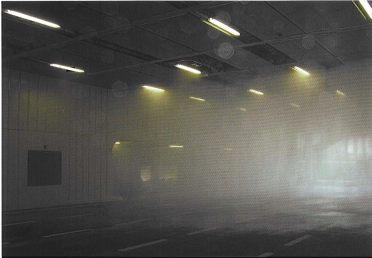
Test of the drenching system on the car deck of a Ro-Ro ferry
4. The ship as its own lifeboat
In open sea, the largest floating object is the ship itself. For the safety of people on board, the main challenge is to keep that ship afloat with the vital systems working, and the next challenge is to return to port. As long as the casualty threshold has not been passed, certain systems should be kept working.
This includes:
Machinery: propulsion, steering, fuel oil transfer, safe area support
Safety: communications, fire and bilge systems, fire safety and damage control.
When these primary systems can be kept alive and the ship is floating it can be decided to stay on board. Then the decision to sail to a nearest port will be made between the crew and the port authorities and others involved.
The first steps for these safety arrangements have to be made in the design period, where impact on propulsion, power generation, duplication of main components in different compartments is essential.
Passenger ships are usually provided with twin propeller arrangements, but when installed in separate engine rooms, it provides possibilities to enhance safety of the vessel. It has impact on pipe and cable routing and is similar to DP systems with their redundancy classes. Electricity in all its forms has to be looked at from this point of view. Duplication of components also means duplication of power cables and cables for control systems.
This philosophy of the ship as its own lifeboat was developed over the recent years and primarily for cruise ships. The number of passengers on cruise ships is growing from 2000 to over 5000 and maybe even more in the years to come. Evacuating these large numbers at sea would be an enormous operation so keeping the ship afloat and in operation to some extent would have great advantages.
When a cargo ship is provided with a twin propulsion system, it is worth investigating the impact on such an arrangement as well.
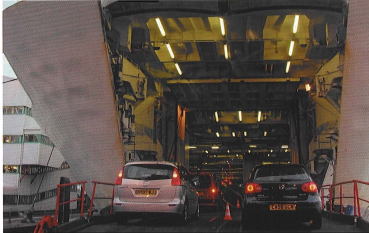
Bow doors of a Ro-Ro car ferry
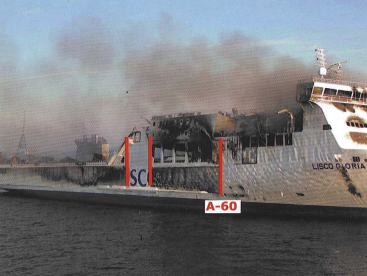
Ferry with the lower car deck on fire. Note the positions of the A-60 bulkheads between the burnt out car deck
and the ventilation ducts and with the accommodation spaces more forward
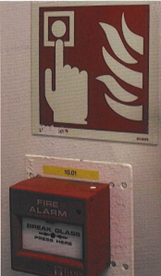
Manual fire alarm push button
 +7 (812) 4-673-673
+7 (812) 4-673-673